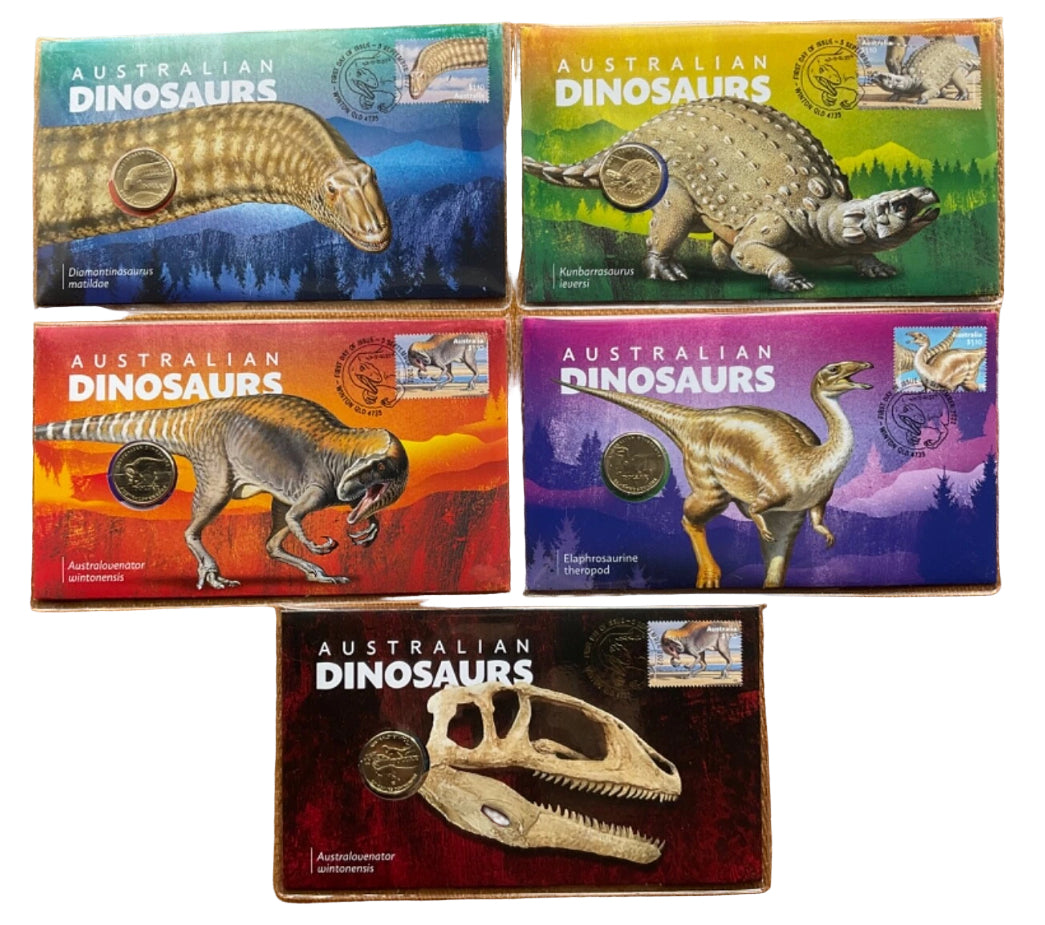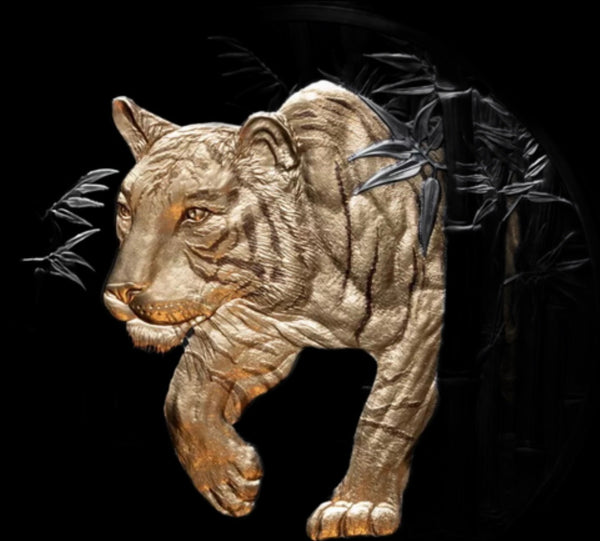Cosican Coins
Australian Dinosaurs PNC 2022 $1 set of 5 with 1 that has Privy Mark
Australian Dinosaurs PNC 2022 $1 set of 5 with 1 that has Privy Mark
Couldn't load pickup availability
Australian Dinosaurs PNC 2022 $1 set of 5 with 1 that has Privy Mark.
AUSTRALIAN DINOSAURS Elaphrosaurine theropod
The Elaphrosaurine Theropod has not yet been assigned to any genus, as its skeleton is so incomplete. It was a toothless theropod ("three-toed") dinosaur species related to Elaphrosaurus (light-footed lizard). This dinosaur has been described from a single neck vertebra bone discovered near Cape Otway in Victoria in 2015. The sediments at the site date from the Early Cretaceous around 110-107 million years ago. During this period, the climate of the Cape Otway region was cold, indicating that this animal could tolerate near-polar temperatures, which were warmer than that area today, as there were no ice caps. It ran low to the ground on two legs, and had a slender body, long neck, stubby arms and possibly toothless skull. It probably had a plant-based diet and did not hunt prey. Evidence suggests that elaphrosaurs started life eating a range of foods, possibly including tiny monotremes, insects and fruits, but shed their teeth as they aged, to be replaced by a horny beak.
Limited to 7,500.
AUSTRALIAN DINOSAURS Kunbarrasaurus leversi
The near-complete fossilised skeleton of Kunbarrasaurus Leversi was discovered in 1989 near Richmond in north-western Queensland. This small, squat, armoured ankylosaur ("fused lizard") dinosaur is the most complete skeleton ever discovered from Eastern Gondwana, and the most complete ankylosaurian skeleton from the entirety of the Gondwanan continents. It lived around the Eromanga Sea 103-101 million years ago, in the Early Cretaceous Period. It was a plant eater, and remains of this individual's last meal were found in its stomach region. Kunbarrasaurus was quadrupedal and covered in bony armour on the head, back, abdomen, legs and along the long tail. Around the size of a modern sheep, it had a parrot-like beak and an inner ear similar to that of a turtle.
Limited to 7,500.
AUSTRALIAN DINOSAURS Diamantinasaurus Matildae
Diamantinasaurus Matildae was a titanosaurian sauropod (meaning lizard-footed)
It lived during the Mid-Cretaceous Period, around 100-95 million years ago in what is now southern central Queensland. This huge, four-legged, long-necked, plant-eating dinosaur is estimated to have measured 16 to 20 metres in length and about two-and-a-half to three metres high at the hip. The first fossilised bones were found in 2005 near Winton, Queensland. Around 30 per cent of the skeleton has been recovered, making it the most complete Cretaceous sauropod ever found in Australia. The known skeleton (nicknamed "Matilda") includes most of the forelimb, shoulder girdle, pelvis, hindlimb and ribs, one shoulder bone, a radius and some vertebrae.
Limited to 7,500.
AUSTRALIAN DINOSAURS Australovenator Wintonensis
Australovenator Wintonensis was a theropod (three-toed) dinosaur that lived during the Mid-Cretaceous Period. Its fossilised bones were discovered near Winten Queensland, intermingled with the bones of Diamantinasaurus. It has been nicknamed "Banjo", and around 40 per cent of its skeleton has been excavated to date, making it the most complete carnivorous dinosaur known from Australia.
Like all carnivorous dinosaurs, Australovenator was two-legged with smaller forelimbs. It was also equipped with three scimitar-shaped claws and sharp teeth.
A swift predator, Australovenator was about one-and-a-half metres high at the hip and five to six metres in length. A claw of this dinosaur has also been found in Early Cretaceous rocks in Victoria and at Lightning Ridge, New South Wales.
Limited to 7,500.
AUSTRALIAN DINOSAURS Australovenator wintonensis
Australovenator Wintonensis was a theropod (three-toed) dinosaur that lived during the Mid-Cretaceous Period. its fossilised bones were discovered near Winton, Queensland, intermingled with the bones of Diamantinasaurus. It has been nicknamed "Banjo", and around 40 per cent of its skeleton has been excavated to date, making it the most complete carnivorous dinosaur known from Australia.
Like all carnivorous dinosaurs, Australovenator was two-legged with smaller forelimbs. It was also equipped with three scimitar-shaped claws and sharp teeth.
A swift predator, Australovenator was about one-and-a-half metres high at the hip and five to six metres in length. A claw of this dinosaur has also been found in Early Cretaceous rocks in Victoria and at Lightning Ridge, New South Wales.
This postal numismatic cover contains a $1 uncirculated AlBr coin featuring the Australia Post envelope privy mark.
Limited to 7,000.
Share


